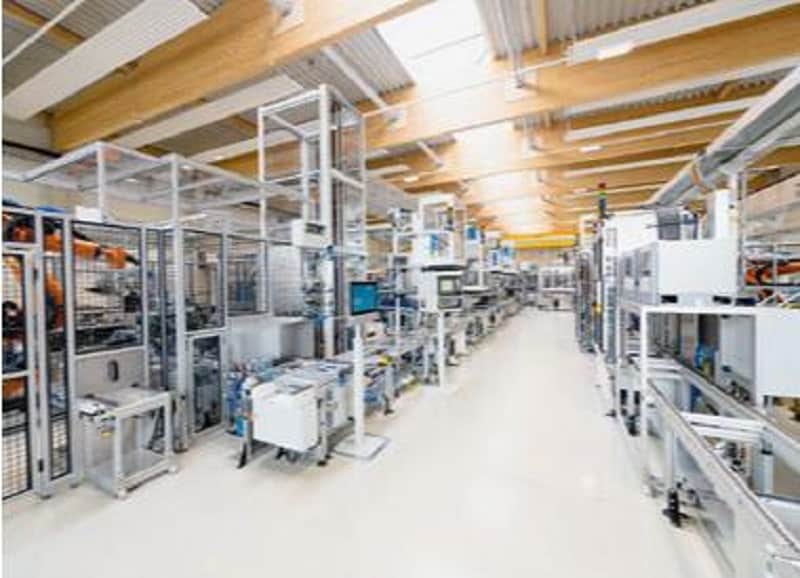Out of time?
Causes unclear: Rejects on the assembly line are too high, cycle times are increasing minimally but steadily, but at first glance it is not clear what the cause is. With large assembly lines, it is often difficult to locate problematic stations or processes in order to identify the potential for optimization. Collecting production data with the help of a software application is the solution.

A large assembly plant for rear axle transmissions of a well-known German automotive supplier illustrates the analyses and evaluations that are possible with the application. This assembly line comprises around 50 stations, all of which are monitored using piaOptimum, a software tool that identifies bottlenecks in complex interlinked assembly lines and, thanks to the greatest possible data transparency, enables rapid and sustainable optimization of production efficiency. It is also possible to take a closer look at individual stations or line sections. However, in order to be able to make statements about OEE losses (Overall Equipment Effectiveness), it makes sense to look at the entire plant in order to track down bottlenecks and malfunctions in their entirety. A station is defined in the software as a plant section at which one or more processing steps are carried out that have the same target cycle time from the start of processing of one component to the start of processing of the next component as the plant as a whole; in this case 55 seconds. This means that a rear axle gearbox is produced every 55 seconds. The stations are usually set up in series. However, there are exceptions where it is not technically possible to complete the machining step in 55 seconds. However, in order not to establish a bottleneck in the assembly process by using slower stations, these stations are executed twice or several times as an integer multiple of the target cycle time. In this way, a system cycle of 55 seconds is achieved in the end.
Data connection via OPC-UA without PLC intervention
By using piaOptimum, the customer wants to create transparency for optimizing the output of his system. This requires data relating to the fundamentals of overall system effectiveness (OEE), i.e. information on the component quality at the end of a processing step (i.e. a station), the associated cycle times and any faults and messages that have occurred. All data points can be configured easily via the software's web interface. This does not require any intervention in the machine control system; instead, piaOptimum enables an absolutely flexible data connection using the already standardized OPC UA protocol - provided that the minimum requirements of the line control system are met. While the data for component quality and cycle times can be easily generated via OPC-UA, details about messages and faults can only be retrieved via HMI panels, whose compatibility must first be checked and in some cases adapted via the respective network structure of the Kun den.
Analysis and optimization of a press station
The following example shows how an analysis at the overall cycle level (from one processing start to the next) and a partial cycle analysis ultimately resulted in a demonstrable improvement in the cycle time: During the period from calendar week 23/2018 to calendar week 25/2018, an analysis was conducted at this station, a pres sen station. This showed that the median of 58.5 seconds was slightly above the target value of 55 seconds. Optimization of the cycle time was therefore necessary here. At station 8, the following processing steps take place in the target cycle time: "Actuator ready", "Secondary time", "Component in position", "Clamp component",
"Pressing process", "Units back". An in-depth analysis of the partial movements made it possible to achieve a shortening of the overall cycle. The optimization measures were carried out in calendar week 26/2018. Afterwards, it became clear that the adaptation of a special partial cycle called "auxiliary time" contributed the main share to the reduction of the total cycle time.
piaOptimum offers the possibility to view the analysis down to the individual movements in the station by means of a so-called reference partial cycle widget on the one hand, and to compare both total and partial cycles with a reference on the other hand. The three weeks week 23/2018 to week 25/2018 were defined as the reference period, the complete following month July 2018 as the analysis period. The reference is always shown as a blue bar in the graphic (Fig. 1), the current analysis values in red, yellow or green, depending on the result of the comparison.
Machine cycle reduced through optimization of "non-productive time
The machine cycle rate in July fell by four percent compared to the pre-optimization period. If you now look at the individual steps in the station, you can see at first glance the main reason for this: Although the steps "Actuator ready", "Component in position" and "Return to position" take a little longer, the optimization of the "Non-productive time" movement was the main reason. The sequence shows that after this step all the following steps start earlier and thus the entire machining process could be shortened. The "non-productive time" is a non-automated movement performed by an operator. The optimization consisted of providing the operator with a better tool for machining - a small change with an amazing effect on the overall cycle time of this station and ultimately on the GAE of the plant. For the following month of July, the median cycle time was reduced to below the target cycle time, in this case 53 seconds, and the fluctuations were also greatly reduced.
Production flow station 8
With the evaluation of the production process of a station (Fig. 2), the user can see how many components were produced in the course of an hour and the quality of the components. The white areas between the bars represent non-production times, e.g. downtimes such as weekends, individual failed shifts or changeover times. The colouring of the peaks gives information about the component quality, green for "component ok", red for "component not ok". This is a different view of station 8. The target cycle time may very well be met. However, if too long a section of the bellows peak was colored red in the above diagram, it would mean that too many of the parts produced in the target cycle time were defective. Here, too, the causes were investigated: malfunctions at the station itself, a faulty measuring method for assessing the quality or poor quality of the processed individual components that originate from subcontractors. In the present example, however, the colorations correspond to the usual and acceptable fluctuations and reject numbers.
Define notification rules
Especially from a maintenance point of view, it is necessary to be alerted as early as possible to a malfunction of the system. Logically linked conditions can be stored for this purpose, which, when fulfilled, actively send a message to one or more recipients by e-mail. A typical example from the plant: A component at various stations is a cylinder that works with air pressure. When the cylinder wears out more and more, the pressure decreases, which even results in a shorter cycle time. For maintenance, this is an indication that the cylinder will fail in the next few days or hours. The notification rule can therefore be set up so that an information e-mail is sent when the cycle time falls below a certain value. In this way, maintenance can prepare everything for an imminent rapid replacement of the cylinder.
Conclusion: Full data transparency for targeted process optimization
In addition to the overall cycle and partial cycle analysis, further informative evaluations can be displayed with piaOptimum and used for production optimization, e.g. displays of the production statistics (the granularity can be defined as desired: the entire line, individual groups or statuses over any free period down to ten-minute packages) or also summary and detailed views of faults and messages that have occurred.
The analyses and evaluations are detailed and multi-layered, so that the production results can be viewed from different angles. The software application provides a wide range of tools for examining a problematic station, evaluating individual line sections or comparing entire production sites with each other. The equipment with pia Optimum is possible both for new plants and as a retrofit version for existing production lines.









